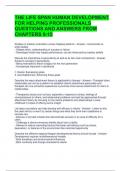THE LIFE SPAN HUMAN DEVELOPMENT
FOR HELPING PROFESSIONALS
QUESTIONS AND ANSWERS FROM
CHAPTERS 9-15
Studies on mastery orientation versus helpless patterns - Answer-- Incremental vs.
entity beliefs
- Shapes effort, understanding of success or failure
- Stereotype threat may impact performance, can be influenced by mastery beliefs
Discuss the importance of generativity as well as its two main components - Answer-
Erikson's concept of generativity:
- Being motivated to leave a legacy for the next generation
- Increasingly important in adulthood
1. Desire: Expressing goals,
2. Accomplishment: Achieving these goals
Describe the ways attachment theory is applicable to therapy - Answer-- Therapist-client
relationship can act as a platform to establish client's attachment personality and
therapist can cue corrective experience to promote more secure attachment for client in
relationships
- Therapeutic issues such as loss, separation, response to stress, feelings of
connectedness to others, and relationship problems can best be approached through
attachment theory by focusing on the clients problems and relationships in early
childhood in hopes of offering some insight.
List ways counselors can help develop self-efficacy in clients - Answer-- Listen to why
the client will try or won't try certain things and what they think their roadblocks to
success are.
- Discuss or provide models who demonstrate success in an area of difficulty for a
client.
- Challenge a clients erroneous beliefs about lack of ability
- Attempt to reduce coexisting factors that lower self-efficacy such as stress,
depression, or features of the environment like restricted opportunity
Describe the different aspects lifespan developmental theory should include - Answer-
Development requires multidimensional models
- Both hereditary and environmental influences
- Both continuity and change characterize adults
,- Adaptation continues from birth to death
Explain the three global processes involved in adaptation to change - Answer-- Growth:
Adding new characteristics, understandings, skills
- Maintenance or resilience: Finding ways to continue or restore functioning after loss
- Regulation of loss: Adjusting expectations and accepting a lower level of functioning
Identify the Big 5 Personality traits as well as biological and environmental influences -
Answer-1. Neuroticism,
2. extraversion,
3. agreeableness,
4. conscientiousness,
5. openness to experience
Biological causes
- Related to brain-mediated systems of approach, fear,
irritability, effortful control, and reactivity
- Stable differences in reactivity, stress response
Environmental influences equally important
- Predictable responses from others
- Relatively stable environments for many
Differentiate between age-graded and history-graded changes - Answer-Age-graded
change = change as a function of time
•Physical changes
•Cognitive changes
•Life tasks and responsibilities
History-graded changes are those that affect the development of a whole cohort
- Examples include The Great Depression, WWII, the
Vietnam War, social changes in 1960s, 9-11
Discuss the physical and cognitive changes in adulthood - Answer-Physical changes in
adulthood
- Declines in sensory ability, reproductive ability
- Changes in appearance (wrinkles, weight)
Cognitive changes in adulthood
- Decline in fluid/mechanical processes, processing speed and inhibition mechanisms
- Stable or increasing crystallized resources, declarative and procedural knowledge
Define fluid intelligence (mechanics) - Answer-Basic operational characteristics that
seem to directly reflect how well the "hardware" of the nervous system is working.
It's functions include such things as processing speed and inhibitory mechanisms.
, Define crystallized intelligence (pragmatics) - Answer-The compilation of skills and
information we have acquired in the course of our lives that can be viewed as the
software programs of our nervous system.
Discuss the roles of chronological age, family-related roles, & membership in a birth
cohort - Answer-Development is influenced by the intersection of
- Chronological age (life time)
- Family-related roles (family time)
- Membership in a birth cohort (historical time)
Year of birth marks entry into a cohort of peers
Define social gradient - Answer-Economic, social status alters impact of events
Define nonnormative events, summarize their potential role in development - Answer-
These events are sudden, unexpected, and individual
- Not predicted by age, not relevant to everyone
- Create a new set of circumstances
- Have potential to alter course of development
Example of a negative nonnormative event:
- Traumatic illnesses, accidents, imprisonment or death
of a loved one
Example of a positive nonnormative event:
- Geographic move for a job promotion, major career
change, economic windfall
Review the concept of generativity - Answer-A primary developmental task of middle
adulthood
•Two components:
- Desire refers to wanting to be creative, productive, or giving
- Accomplishment means actually feeling that you are creative, productive, or giving
- Desire more characteristic of young adults
- Accomplishment more typical of middle adults
Review the concept of intimacy; discuss the impact of intimacy in midlife - Answer-Good
marriages or primary relationships (intimacy) confer important physical and
psychological benefits
• Higher levels of happiness
• Higher sexual and emotional satisfaction
• Lower rates of mental illness, drug and alcohol abuse and physical illness
• Economic benefits and protective factors
• Tendency to live longer




